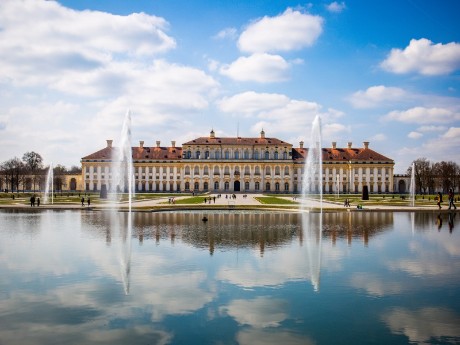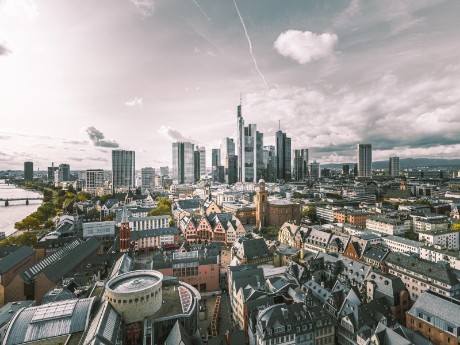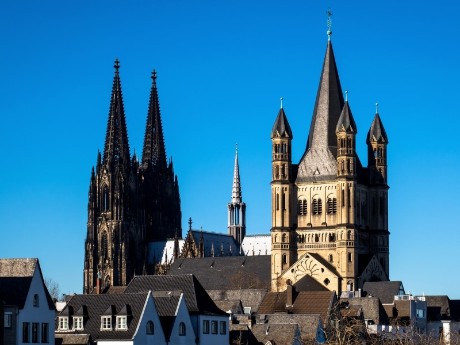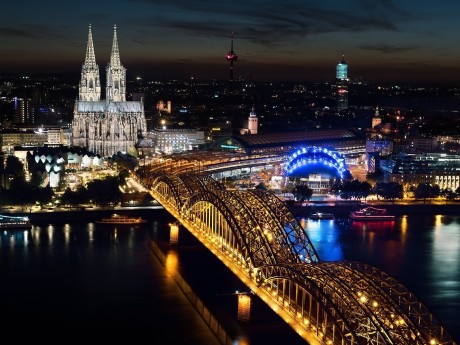Germany: Munich, Frankfurt & Cologne
Explore Germany’s captivating heritage through the enchanting cities of Munich, Frankfurt and Cologne. Find breathtaking architecture in Munich’s Marienplatz, take a guided cruise of Frankfurt’s River Main or an evening panorama cruise on the Rhine River of Cologne. Those who enjoy the outdoors can spend time at some of Munich’s delightful parks including the English Garden and Olympia Park (the location of the 1972 Olympic Games) or wandering through Frankfurt’s Römerberg.
Read more
Explore Germany’s captivating heritage through the enchanting cities of Munich, Frankfurt and Cologne. Find breathtaking architecture in Munich’s Marienplatz, take a guided cruise of Frankfurt’s River Main or an evening panorama cruise on the Rhine River of Cologne. Those who enjoy the outdoors can spend time at some of Munich’s delightful parks including the English Garden and Olympia Park (the location of the 1972 Olympic Games) or wandering through Frankfurt’s Römerberg. Take in panoramic views of Frankfurt through the Main Tower’s observation deck. Marvel at the Cologne Cathedral or visit the city’s chocolate museum. Travelling between cities by train also allows you to take in the magnificent views along the journey. Waterviews strives to offer accommodation options within walking distance of water and/or in an area of touristic interest. Our prices include taxes (but excludes local tourist taxes). Customize your trip to your personal preferences with optional activities (hit the “Add Activities’’) or change hotels, etc. Contact us for customization at no extra cost at: Service@waterviewstravel.com
Destinations
- Munich
- Frankfurt
- Cologne
Itinerary
Munich

Munich is located near the snow-capped Bavarian Alps and boasts beautiful nature all around as well as many green spaces and parks within the city. It is a modern metropolis, home to the world-renowned BMW cars, but also honours its traditions, the most well-known being the Oktoberfest, which is an ode to Munich’s many breweries. Those interested in sampling local dishes should head to the Victuals Market or any of the beer gardens, while for a more sophisticated experience several world-class museums await to be visited.
Read more
Munich is located near the snow-capped Bavarian Alps and boasts beautiful nature all around as well as many green spaces and parks within the city. It is a modern metropolis, home to the world-renowned BMW cars, but also honours its traditions, the most well-known being the Oktoberfest, which is an ode to Munich’s many breweries. Those interested in sampling local dishes should head to the Victuals Market or any of the beer gardens, while for a more sophisticated experience several world-class museums await to be visited.
Additional Information
History
The year 1158 is the earliest date the city is mentioned in a document signed in Augsburg. By that time, Henry the Lion had built a bridge over the river Isar next to a settlement of Benedictine monks. Almost two decades later, in 1175 Munich was officially granted city status and received fortification. In 1180, with the trial of Henry the Lion, Otto I Wittelsbach became Duke of Bavaria and Munich was handed over to the Bishop of Freising. The Wittelsbach dynasty would rule Bavaria until 1918. In 1255, when the Duchy of Bavaria was split in two, Munich became the ducal residence of Upper Bavaria. In the late 15th century, Munich underwent a revival of Gothic arts: the Old Town Hall (Altes Rathaus) was enlarged, and Munich's largest Gothic church, the Frauenkirche cathedral, was constructed in only 20 years, starting in 1468.
When Bavaria was reunited in 1506, Munich became its capital. The arts and politics became increasingly influenced by the court, and Munich became a centre of the German counter-reformation as well as of Renaissance arts. The Catholic League was founded in Munich in 1609. During the Thirty Years' War, Munich became an electoral residence. In 1632, the city was occupied by Swedish King Gustav II Adolph.
After World War I, the city was at the centre of political unrest. In November 1918, on the eve of revolution, the royal family fled the city. After the murder of the first republican premier of Bavaria in February 1919, the Bavarian Soviet Republic was proclaimed, but it was put down on 3 May 1919 by conservative troops. As a result of this turmoil, the first republican constitution enacted for Bavaria was drafted in Bamberg — about as far as you can get from Munich and still be under Bavarian administration. While the republican government had been restored, Munich became a hotbed of extremist politics, among which Adolf Hitler and National Socialism rose to prominence. In 1923 Hitler and his supporters, who were then concentrated in Munich, staged the Beer Hall Putsch, an attempt to overthrow the Weimar Republic and seize power. The revolt failed, resulting in Hitler's arrest and the temporary crippling of the Nazi Party, which was virtually unknown outside Munich at that time.
The city again became a Nazi stronghold when the National Socialists took power in Germany in 1933. The National Socialist Workers Party created the first concentration camp at Dachau, 15 km (10 mi) north-west of the city. Because of its importance to the rise of National Socialism, Munich was referred to as the "Capital of the Movement" ("Hauptstadt der Bewegung"). Munich was also the base of the White Rose (Weiße Rose), a student resistance movement from June 1942 to February 1943. However, the core members — including Hans and Sophie Scholl — were arrested and executed following a distribution of leaflets at the University of Munich. The city was heavily damaged by allied bombing during World War II, with 90% of the historic city centre and 50% overall destroyed.
After the US occupation in 1945, Munich was completely rebuilt. Munich was the site of the 1972 Olympic Summer Games, during which Israeli athletes were assassinated by Palestinian terrorists. The badly botched rescue attempt (Germany did not have anything but regular police to deal with a situation like this) led to the founding of GSG9 one of the best regarded special forces groups which survived its baptism of fire just five years later in the successful freeing of the airplane "Landshut" which had been abducted to Mogadishu by Palestinian terrorists working together with German leftists.
Economy
Munich is the German economic powerhouse, with six out of the 30 companies listed in the German blue-chip stock-market index DAX. These include luxury car maker BMW, electrical engineering giant Siemens, and the world's largest insurance company Allianz.
The Munich region is a centre for aerospace, biotechnology, software and service industries. As the largest publishing city in Europe, Munich is home to Süddeutsche Zeitung, one of Germany's largest and most influential daily newspapers. Germany's largest commercial network, Pro7-Sat1 Media AG is located in Eastern Munich.
Munich's flourishing local economy is reflected in its place in quality-of-life rankings of world cities. Monocle magazine even named it the world's most livable city in 2010. People continue to flock into the city due to its proximity to the Alps and some of the most beautiful scenery in Europe, especially Baroque and Rococo architecture and green countryside which starts a mere half hour away on the S-Bahn. However, there's a price to pay for living here: Munich is the most expensive city in Germany. Real estate development and hotel construction are a regular sight, but so far, demand outstrips supply by far.
Culture
The people of Munich do not like their city to be associated only as a city of beer and the Oktoberfest, and indeed the Bavarian kings transformed Munich into a city of arts and science in the 19th century, and also quite notable architecture. Many of the city's finest buildings belong to this period and were built under the first three Bavarian kings during the first half of the 19th century. Munich's outstanding position among other German cities may have faded a bit, due to Berlin becoming the German capital again in the 1990s, but it is still a vibrant and important city of culture.
The Nationaltheater, where several of Richard Wagner's operas had their premières under the patronage of King Ludwig II, is the home of the world famous Bavarian State Opera and the Bavarian State Orchestra. Next door the modern Residenz Theatre was erected in the building that had housed the Cuvilliés Theatre before World War II. Many operas were staged there, including the premiere of Mozart's "Idomeneo" in 1781. The Gärtnerplatz Theatre is a ballet and musical state theatre, while another opera house, Prinzregententheater has become the home of the Bavarian Theatre Academy. The modern Gasteig Center houses the Munich Philharmonic Orchestra.
Many prominent writers worked in Munich. During the period immediately before World War I, the city became economically and culturally prominent. Munich, and especially its then suburbs of Schwabing and Maxvorstadt, became the domicile of many artists and writers. Nobel laureate Thomas Mann, who also lived there, wrote ironically in his novella Gladius Dei about this period, "Munich shone". It remained a center of cultural life during the Weimar period with figures such as Bertolt Brecht and Lion Feuchtwanger.
Bavaria has been the long-time antipode of Berlin: while the Protestant Prussian kings focused on building military strength, Bavaria's Catholic Wittelsbach kings were more interested in creating a centre of arts and science following the examples of cities in northern Italy. Bavaria takes a position among the German states with a strong emphasis on its independence and has its own conservative party, the Christian Social Union (CSU), which strongly advocates Bavarian interests in Berlin. Unlike Berlin which for historical reasons has been cut off from the surrounding Brandenburg countryside, or Hamburg which prides itself of being a free Hanseatic city, Munich can rely on a local elite willing and eager to shovel state funds its way to the never-ending chagrin of people in other areas administered by Munich such as Franconia. If a royal residence since the early 1800s and subsequently the capital of Germany's most independent minded state looks the part, it is in no small part due to the Munich-centric Bavarian politics and the special role of the CSU since 1949. Among other things, the CSU has 3 ministers in the federal government inaugurated in 2018 while East Germany has none.
Münchner share a lot of characteristics with the rest of Bavaria and it has become popular again among older and younger people to wear traditional Bavarian clothing, at least during the Oktoberfest and similar traditional beer festivals. One notable difference is politics: whereas the rest of Bavaria is a stronghold of conservative Catholicism, Munich has been governed by a liberal coalition of Social Democrats, Greens and the Rosa Liste (a gay rights party). Only 36.2% of its residents are members of the Catholic church while 13.3% are Protestant, 0.3% Jewish and 50.3% are members of another religion or follow no religion.
Language
The official language in Munich is, of course, German. With many Munich residents coming from other German regions or from abroad, "Standard German" dominates as the spoken language in Munich. Nevertheless, some residents speak with a more or less strong Bavarian dialect, which can deviate substantially from the German taught at schools.
Are your German skills limited? Worry not. English is widely spoken and understood throughout the city in restaurants, cafés, tourist attractions and shops. In fact, most of Munich's citizens actually speak really good English, often with levels of fluency that rival those of the Nordic countries. Furthermore, Munich has been the destination of waves of immigrants, particularly from Turkey, the former Yugoslavia, Italy, Greece, the Middle East, and France. However, second or third generation descendants of immigrants do not necessarily speak "the old language" that well or at all.
Climate
Munich has a continental climate, strongly modified by the city's altitude and proximity to the northern edge of the Alps. This means that precipitation is high, and rainstorms can come violently and unexpectedly.
Winters last from December to March. Munich experiences cold winters, but heavy rainfall or snowfall is rarely seen in the winter. The coldest month is January with an average temperature of −2.2°C (28.0°F). Snow cover is seen for at least a couple of weeks during winter. Summers in Munich are warm and pleasant, with an average maximum of 23.8°C (73.8°F) in the hottest months. Summers last from May until September.
An oddity of Munich is the föhn wind, a warm and dry down-slope wind from the Alps, which can raise temperatures sharply within a few hours, even in winter, and increases the range of sight to more than 100 km (60 mi). These winds are sometimes associated with illnesses ranging from migraines to psychosis. The first clinical review of these effects was published by the Austrian physician Anton Czermak in the 19th century. Residents of Munich sometimes use the Föhn as an excuse for having a bad mood, which should not be taken too seriously.
Tourism office
© Sourced from Wikivoyage
Frankfurt

Frankfurt, located on the river “Main” (pronounced ‘mine’), is a business hub. It is home to one of the world’s largest stock exchanges, the headquarters of the European Central Bank and the host of many important trade fairs hence attracting many business travellers. However, it also has many things to offer for a more leisurely visit. For example its old town with quaint medieval buildings, outdoor cafés, boutiques, parks, the option of a river cruise, as well as a wide variety of museums, nightlife and entertainment.
Read more
Frankfurt, located on the river “Main” (pronounced ‘mine’), is a business hub. It is home to one of the world’s largest stock exchanges, the headquarters of the European Central Bank and the host of many important trade fairs hence attracting many business travellers. However, it also has many things to offer for a more leisurely visit. For example its old town with quaint medieval buildings, outdoor cafés, boutiques, parks, the option of a river cruise, as well as a wide variety of museums, nightlife and entertainment.
Additional Information
Frankfurt is a city of contrasts. Wealthy bankers, students and hippie drop-outs coexist in a city that has some of the highest, most avant-garde skyscrapers of Europe next to well maintained old buildings. The downtown area, especially Römer square and the museums at the River Main, draw millions of tourists every year. On the other hand, many off-the-beaten-track neighbourhoods, such as Bockenheim, Bornheim, Nordend and Sachsenhausen, with their intact beautiful 19th-century streets and parks are often overlooked by visitors.
It's the heart of the Rhine-Main region, spanning from Mainz and Wiesbaden in the west to Hanau in the east and Gießen in the north to Darmstadt in the south and has some 5,500,000 inhabitants in the whole surrounding metropolitan area.
Frankfurt is the place where Germany's major autobahns and railways intersect. About 650,000 people commute to the city each day, not counting some 700,000 people who live here. With a huge airport — the third-largest in Europe — it is the gateway to Germany and for many people also the first point of arrival in Europe. Further, it is a prime hub for interconnections within Europe and for intercontinental flights.
In the years following 1968, especially in the late 1970s and up to the early 1980s, Frankfurt was a centre of the left wing Sponti-Szene, which frequently clashed with police and local authorities over politics and urban design issues (specifically whether or not old buildings should be torn down). Several members of these radical groups went on to have quite respectable careers in politics, among them Daniel Cohn-Bendit (long time leading MEP for the Greens) and Joschka Fischer (Foreign Minister and Vice Chancellor 1998-2005), though their erstwhile radical and violent antics did hurt them in their later political careers.
Frankfurt has one of the highest percentage of immigrants in Germany: about 25% of Frankfurt's people have no German passport and another 10% are naturalized German citizens. With about 35% immigrants, Frankfurt is one of the most diverse of German cities.
Frankfurt is home to many museums, theatres and a world-class opera.
Territorial subdivisions
Frankfurt is divided into 16 Ortsbezirke, which are further subdivided into 46 Stadtteile. As Frankfurt is an expansive city with a large area given its population, most of those are of little interest to a tourist, with most attractions concentrated in the Ortsbezirk Innenstadt I (there are four Ortsbezirke starting with Innenstadt ("inner city"), distinguished by Roman numerals). Some Stadtteile of particular note are: Altstadt (Römer areal) - the heart of Frankfurt's old town, largely rebuilt after the Second World War Innenstadt - named confusingly (sharing its name with the larger Ortsbezirke) is the part embracing the Altstadt up until the old city fortifications, still visible as a green belt on the city map. The home to the most of Frankfurt's skyscrapers Bahnhofsviertel - the densely-built part of the city immediately facing the Hauptbahnhof, hosting the most hotels in town and its red light district Gutleutviertel - the area south of the tracks leading up to the Hauptbahnhof, with a modern residential quarter on the Main Gallus - the area north of the Hauptbahnhof tracks known most for the past-2010 Europaviertel development (a new city quarter with apartment blocks and offices built around the wide Europaallee next to the fairgrounds) Bockenheim Westend - the most expensive part of Frankfurt by land values, mostly covered with low-rise residential buildings and villas, but also several skyscrapers on its edges Nordend Bornheim – Popular area with small shops, cafés and restaurants, as well as historic taverns and half-timbered houses. See listing below. Sachsenhausen - the historic southern bank of the river Main, which preserved its typical 19th-century character, very different from the modern northern bank punctured by skyscrapers. Includes the Museumsufer museum collection directly at the riverbank. See listing below for further details. Höchst – Formerly a separate small town, now a suburb. The small Altstadt, around the Schloss, is one of the closest places to central Frankfurt that you can see large numbers of traditional timber-framed buildings that didn't get destroyed in the war. The square by the Schloss has some very nice traditional Gaststätte to eat or drink in. See listing below for further details.
When to visit
The best times for Frankfurt are late spring to early autumn. The summers tend to be sunny and warm around 25°C (77°F). Be prepared, however, for very hot summer days around 35°C (95°F) as well as for light rain. The winters can be cold and rainy (usually not lower than -10°C/14°F). It rarely snows in Frankfurt itself.
If you intend to stay overnight, you may wish to avoid times when trade fairs are held, as this will make finding affordable accommodation a challenging task. The biggest are the Frankfurt Motor Show (Automobil-Ausstellung) every two years in mid-September (next in 2017) and the Book Fair (Buchmesse) yearly in mid-October; see Fairs for details.
Tourist information
There are two offices for tourism information:
© Sourced from Wikivoyage
Cologne

Cologne was founded by the Romans in 38 BC and grew into a major trading center with its cathedral dominating the skyline. Although most of it had to be rebuilt after WWII, the city is charming and has many things to offer. On your walks you may stumble across Roman mosaics and remainders of ancient walls. There are museums for every taste, several zoos and breweries making the famous ‘Kölsch’ beer. If you happen to be here during the Carnival early in the year, be prepared to find the city in an all-day party for 6 days straight.
Read more
Cologne was founded by the Romans in 38 BC and grew into a major trading center with its cathedral dominating the skyline. Although most of it had to be rebuilt after WWII, the city is charming and has many things to offer. On your walks you may stumble across Roman mosaics and remainders of ancient walls. There are museums for every taste, several zoos and breweries making the famous ‘Kölsch’ beer. If you happen to be here during the Carnival early in the year, be prepared to find the city in an all-day party for 6 days straight.
Additional Information
Orientation
Cologne lies on both sides of the river Rhine, which flows through it in a northerly direction. The left hand, or western side, is Cologne proper with the Old Town (Altstadt), the famous cathedral and most landmarks and museums. The right side, or eastern side, used to be a separate town called Deutz - now Deutz is a neighbourhood of Cologne.
Cologne is divided into 9 districts (Stadtbezirke), numbered from 1 to 9. Stadtbezirk 1, called Innenstadt ("inner city"), is probably the one most tourists will spend all of their time in, as it contains most of the city's points of interest. It is also the only district that lies on both sides of the Rhine, as it includes Deutz. Districts 2, 3, 4, 5 and 6 are on the western bank of the Rhine, and districts 7, 8 and 9 on the eastern bank, surrounding the Innenstadt.
Every Stadtbezirk is further divided into Stadtteile (literally "city parts", or "neighbourhoods"). The Innenstadt includes Altstadt-Nord and Alstadt-Süd, two parts of the historic Old Town of Cologne facing the Rhine, divided by the L111 thoroughfare running from east to west (with the street names Cäcilienstraße – Neumarkt – Hahnenstraße), starting at the Deutzer Brücke (bridge over the Rhine). The Altstadt is surrounded by a ring of wide avenues running over the former city walls of Cologne. They all have street names ending with the word Ring.
The part of Innenstadt lying on the outer side of the ring is the Neustadt, or "new town". Neustadt is further divided into Neustadt-Nord and Neustadt-Sued, also separated by L111 (Aachener Straße). Both parts of the Neustadt form a crescent embracing the Altstadt and reaching the Rhine on either side thereof. Finally, facing the Altstadt and Neustadt on the other (eastern) side of the Rhine is the Stadtteil of Deutz, which completes the Innenstadt.
History
Cologne is one of the oldest cities in Germany, having been founded and established in the 1st century AD, as the Roman Colonia Claudia Ara Agrippinensium. "Cologne" is the French version of the city's name, which has become standard in English as well. It has a traditional, strong rivalry with the neighbouring city of Düsseldorf, the capital of North Rhine-Westphalia, although this is mostly manifested by a number of jocular references made to one another in both cities and constant bickering as to whose local beer is best (in Cologne, it is obviously Kölsch). It was Germany's largest city at several points in history and for most of the Middle Ages it was the only place that would even register as a major city population-wise by modern standards. Today it is the fourth biggest city in Germany (after Berlin, Hamburg and Munich) and the biggest that is neither city state nor state capital. Its population is around one million people.
Climate
The climate of North Western Germany is changeable, with seasonal changes and day-to-day weather often comparable to that of the England or Northern France. Travellers to Cologne can expect the hottest time of the year to be late July/early August, the coldest is January (temperature hovering around the freezing mark) and the month with the most rainfall is June.
Tourist office
© Sourced from Wikivoyage





